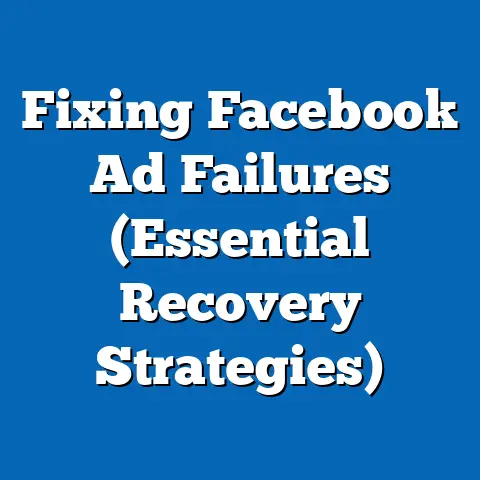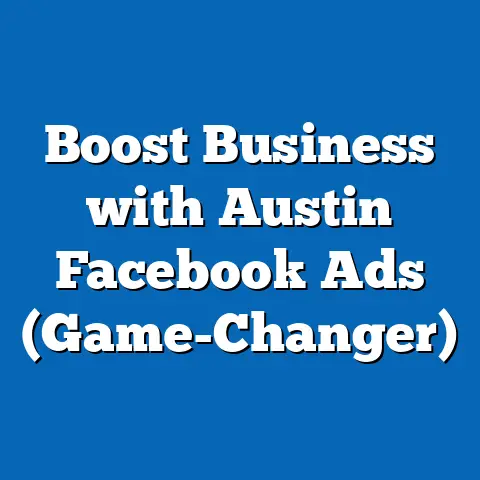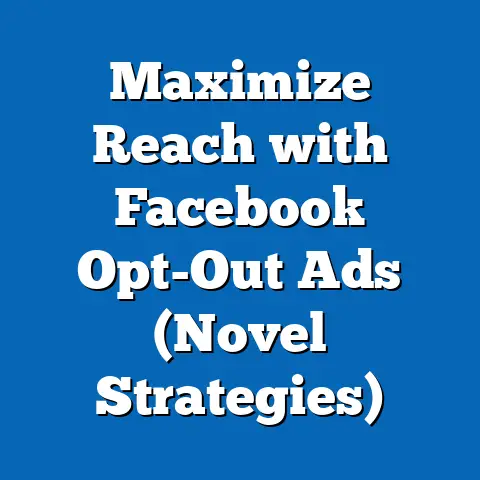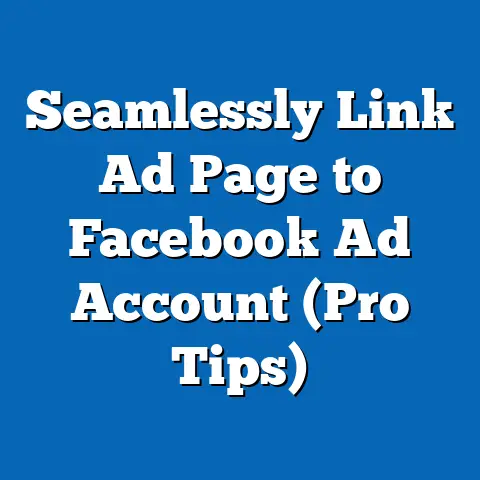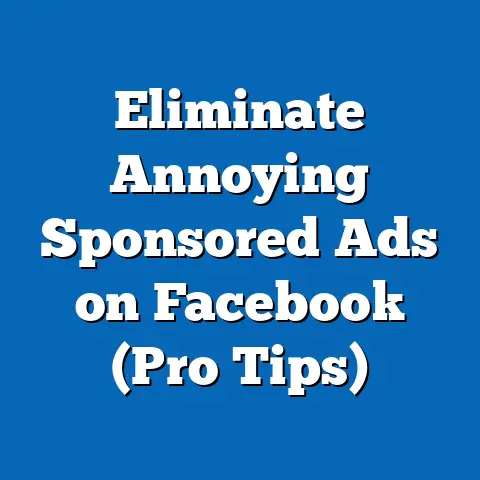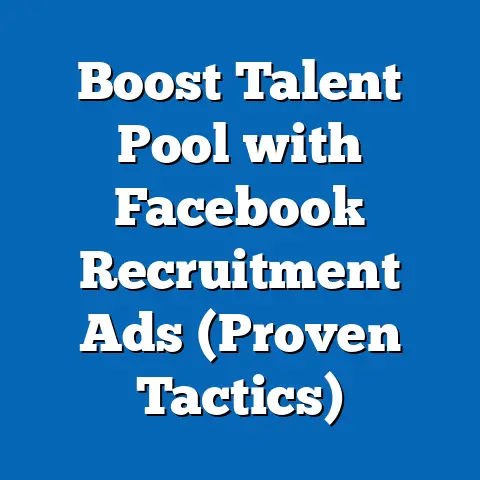Stop Facebook Ads in Videos (Proven Tactics Unveiled)
We’re about to dive deep into the world of Facebook advertising within video content, and more specifically, how to navigate the often-turbulent waters of ad interruptions. If you’ve ever felt like a perfectly good streaming session was hijacked by an overly persistent ad, you’re not alone. I’ve been there too, both as a consumer and as a marketer trying to strike the right balance. Let’s get started!
Understanding the Facebook Ads Ecosystem: A Necessary Evil or a Powerful Tool?
Facebook ads, they’re everywhere, right? It’s almost impossible to scroll through your feed without encountering some form of sponsored content. Now, I’m not here to bash Facebook ads. In fact, I’ve used them extensively to drive traffic, generate leads, and boost brand awareness for my clients. When done right, they can be incredibly effective. But the key phrase here is “when done right.”
When ads are poorly targeted, irrelevant, or overly intrusive, they can do more harm than good. Think of it like this: Facebook is a bustling city, and ads are the billboards. Some billboards are eye-catching and informative, while others are just plain annoying.
The Numbers Don’t Lie: Video Ad Performance on Facebook
Let’s look at some stats. According to recent reports, video ads on Facebook have an average engagement rate of around 6%. That’s not bad, but it’s crucial to remember that this is just an average. Some videos perform exceptionally well, while others fall flat. The key differentiator is often the user experience.
Another vital metric is viewer retention. How long are people actually watching your video ad? Studies show that most viewers drop off within the first few seconds. If your ad is interrupting their viewing experience, you’re likely to see an even steeper drop-off rate.
And then there’s the click-through rate (CTR). A high CTR indicates that your ad is resonating with your target audience and driving them to take action. However, a low CTR could be a sign that your ad is disruptive or irrelevant.
The User Experience Factor: Walking a Tightrope
Here’s where things get tricky. Facebook wants advertisers to spend money, but they also want users to have a positive experience. If users are constantly bombarded with intrusive ads, they’re going to get frustrated and may even leave the platform. This is a delicate balancing act.
I remember one campaign I ran for a local coffee shop. We initially used a standard video ad format with a hard sell approach. The results were dismal. People were skipping the ad as soon as possible, and we were getting negative comments on the post. We quickly realized that we needed to change our strategy. We ended up creating a short, engaging video that told the story of the coffee shop and its commitment to quality. The results were dramatically better.
Takeaway: Facebook advertising can be highly effective, but it’s essential to prioritize the user experience. Avoid intrusive ad formats and focus on creating content that adds value to the viewer.
The Psychology Behind Ad Interruptions: Why Do We Hate Them So Much?
Okay, let’s get into the nitty-gritty of why people find ad interruptions so annoying. It’s not just about being interrupted; it’s about the underlying psychological factors at play.
Cognitive Load Theory: Overloading the Brain
Cognitive load theory suggests that our brains can only process a limited amount of information at any given time. When we’re watching a video, we’re already using a certain amount of cognitive resources to understand the content. When an ad pops up unexpectedly, it adds to that cognitive load.
This overload can lead to viewer disengagement. People become less focused on the video they were watching and more focused on getting rid of the ad. This is not a recipe for effective advertising.
Emotional Responses: From Annoyance to Frustration
Think about how you feel when you’re engrossed in a captivating video, and suddenly, an ad interrupts you. Chances are, you’re not thrilled. You might feel annoyed, frustrated, or even angry. These negative emotional responses can be detrimental to your brand.
I once worked with a client who ran a series of pre-roll ads on YouTube. These ads played before the main video content. While the ads were well-produced and informative, they were consistently met with negative feedback. People felt like they were being forced to watch something they didn’t want to see. We ended up switching to a skippable ad format, which allowed viewers to skip the ad after a few seconds. The results were much better.
Viewer Retention: Losing the Battle for Attention
Interruptions can lead to a significant decrease in viewer retention. If an ad pops up at a crucial moment in a video, viewers are likely to lose interest and may even click away. This is especially true for younger audiences, who have shorter attention spans and are less tolerant of intrusive advertising.
Takeaway: Ad interruptions can overload the brain, trigger negative emotional responses, and decrease viewer retention. Understanding these psychological factors is crucial for creating more effective and less disruptive advertising campaigns.
Proven Tactics to Stop Facebook Ads in Videos: Taking Back Control
Now, let’s get to the good stuff. What can you actually do to stop or minimize the impact of Facebook ads in videos? Here are some proven tactics that I’ve seen work:
Ad Blockers: The Shield Against Intrusions
Ad blockers are software programs that prevent ads from appearing on websites and in videos. They work by identifying and blocking the code that serves ads. Ad blockers have become increasingly popular in recent years, as more and more people become fed up with intrusive advertising.
While ad blockers can be effective at stopping ads, they also have some drawbacks. For one, they can negatively impact the revenue of websites and content creators who rely on advertising to support their work. Additionally, some ad blockers can be intrusive themselves, slowing down your browsing speed or collecting your data.
User Settings: Customizing Your Ad Experience
Facebook allows users to customize their ad experience through their settings. You can control the types of ads you see, opt out of targeted advertising, and even block specific advertisers.
To access your ad settings, go to your Facebook profile and click on the drop-down menu in the top right corner. Select “Settings & Privacy” and then “Settings.” From there, click on “Ads” in the left-hand menu.
Here are some of the options you’ll find:
- Ad Preferences: This allows you to control the types of ads you see based on your interests, demographics, and browsing history.
- Ad Settings: This allows you to opt out of targeted advertising based on data from Facebook partners.
- Advertisers You’ve Interacted With: This allows you to see a list of advertisers you’ve interacted with and block specific advertisers.
Content Creation Strategies: The Art of Subtle Persuasion
Perhaps the most effective way to stop Facebook ads from being intrusive is to create content that doesn’t feel like an ad at all. This is where content creation strategies come into play.
Native Advertising: Blending In
Native advertising is a form of advertising that blends in with the surrounding content. It’s designed to look and feel like a natural part of the viewing experience. Native ads can take many forms, including sponsored articles, in-feed videos, and branded content.
The key to successful native advertising is to provide value to the viewer. Don’t just try to sell them something; offer them something useful, informative, or entertaining.
Engaging Storytelling: Captivating the Audience
Storytelling is a powerful tool for keeping viewers engaged. When you tell a compelling story, people are more likely to pay attention and less likely to be bothered by the fact that you’re trying to sell them something.
I remember working with a non-profit organization that was struggling to raise awareness for their cause. We decided to create a series of short videos that told the stories of people who had been helped by the organization. These videos were incredibly effective. People were moved by the stories and were more likely to donate to the organization.
Utilizing Organic Reach: The Power of Community
Organic reach refers to the number of people who see your content without you having to pay for advertising. While organic reach has declined on Facebook in recent years, it’s still a valuable tool for reaching your target audience.
The key to increasing organic reach is to create content that people want to share. This means creating content that is informative, entertaining, or emotionally engaging. It also means actively engaging with your audience and building a community around your brand.
Takeaway: There are several tactics you can use to stop or minimize the impact of Facebook ads in videos. These include using ad blockers, adjusting your user settings, and creating content that doesn’t feel like an ad.
The Future of Facebook Ads in Video Content: What’s on the Horizon?
The world of digital advertising is constantly evolving. What works today may not work tomorrow. So, what does the future hold for Facebook ads in video content?
Trends in Digital Advertising: A Glimpse into Tomorrow
Several emerging trends could affect the use of Facebook ads in videos. These include:
- The Rise of Short-Form Video Content: Platforms like TikTok and Instagram Reels have popularized short-form video content. This trend could lead to a shift away from longer, more traditional video ads.
- The Integration of Augmented Reality (AR): AR is becoming increasingly popular in advertising. Brands are using AR to create interactive experiences that allow users to try on products virtually or explore virtual environments.
- The Growing Importance of Personalization: Consumers are demanding more personalized experiences. Brands are using data to create ads that are tailored to individual users’ interests and preferences.
Shifts in Consumer Behavior: Understanding the New Norm
Consumer preferences are also changing. Younger demographics are particularly averse to intrusive advertising. They prefer content that is authentic, engaging, and provides value.
This means that advertisers need to be more creative and strategic in their approach. They need to focus on creating content that resonates with their target audience and avoids being disruptive.
Potential Solutions: Facebook’s Role in Shaping the Future
Facebook is aware of the challenges posed by intrusive advertising. The company is constantly experimenting with new ad formats and technologies to improve the user experience.
Some potential solutions include:
- Non-Intrusive Ad Formats: Facebook could develop new ad formats that are less disruptive to the viewing experience.
- Improved Targeting: Facebook could improve its targeting capabilities to ensure that ads are only shown to users who are likely to be interested in them.
- User Controls: Facebook could give users more control over the types of ads they see.
Takeaway: The future of Facebook ads in video content is uncertain. However, it’s clear that advertisers need to adapt to changing trends and consumer preferences.
Case Studies and Real-World Examples: Learning from the Best
Let’s take a look at some real-world examples of brands that have successfully minimized ad interruptions and created engaging content that resonates with their target audience.
Successful Campaigns: Lessons in Engagement
- Dove’s “Real Beauty” Campaign: Dove’s “Real Beauty” campaign is a classic example of successful storytelling. The campaign featured videos that challenged traditional beauty standards and celebrated diversity. These videos were incredibly engaging and generated a lot of positive buzz for the brand.
- GoPro’s User-Generated Content: GoPro has built a successful brand by relying heavily on user-generated content. The company encourages its customers to share their videos and photos, which are then featured on GoPro’s social media channels. This approach has allowed GoPro to create authentic and engaging content without having to rely on traditional advertising.
- Old Spice’s “The Man Your Man Could Smell Like” Campaign: Old Spice’s “The Man Your Man Could Smell Like” campaign is a masterclass in humor and wit. The campaign featured a series of hilarious videos that went viral and helped to revitalize the Old Spice brand.
Lessons Learned: Replicating Success
What can we learn from these case studies? Here are some key takeaways:
- Tell a Story: People love stories. When you tell a compelling story, you’re more likely to capture their attention and keep them engaged.
- Be Authentic: Authenticity is key. People can spot a fake a mile away. Be true to your brand and your values.
- Provide Value: Don’t just try to sell something; offer something useful, informative, or entertaining.
- Engage with Your Audience: Actively engage with your audience and build a community around your brand.
Consumer Feedback: The Voice of the Viewer
It’s important to listen to consumer feedback. What are people saying about your ads? Are they finding them intrusive or engaging? Use this feedback to improve your campaigns and create a better user experience.
Takeaway: There are many lessons to be learned from successful advertising campaigns. By studying these campaigns and listening to consumer feedback, you can create more effective and less disruptive ads.
Conclusion: Adapting to the Ever-Changing Landscape
We’ve covered a lot of ground in this article. We’ve discussed the negative impact of ad interruptions, the psychological factors at play, and the tactics you can use to minimize the impact of ads in videos. We’ve also looked at some real-world examples of successful campaigns and discussed the future of Facebook ads in video content.
Recap Key Points: A Quick Review
Let’s recap the key points:
- Ad interruptions can be annoying and detrimental to your brand.
- Understanding the psychology behind ad interruptions is crucial for creating more effective ads.
- There are several tactics you can use to stop or minimize the impact of ads in videos.
- The future of Facebook ads in video content is uncertain, but it’s clear that advertisers need to adapt to changing trends and consumer preferences.
Call to Action: Taking the Next Step
Now it’s time to take action. Implement the tactics discussed in this article to enhance the viewer experience and engagement. Experiment with different ad formats and content creation strategies to find what works best for your brand.
Final Thoughts: Embracing the Evolution
The world of digital marketing is constantly evolving. What works today may not work tomorrow. It’s essential to stay up-to-date on the latest trends and technologies and to be willing to adapt your strategies as needed. Just like the weather, the digital landscape is unpredictable. But with the right knowledge and tools, you can navigate the storms and emerge stronger than ever.
And that’s a wrap! I hope you found this guide helpful. Now go out there and create some amazing video content that engages your audience without being intrusive. Good luck!

